CSR Limited: Financial Reporting Issues Analysis Report
VerifiedAdded on 2023/05/27
|10
|2306
|204
Report
AI Summary
This report analyzes four key accounting issues within the financial statements of CSR Limited, an Australian building industry company. The report identifies issues in product liability provision, asset valuation (including goodwill impairment), lease accounting, and the recognition and measurement of financial derivatives. The analysis highlights the uncertainties and judgments involved in each area, such as the assumptions used in estimating product liability provisions, the application of impairment trigger analysis for asset valuation, the impact of lease accounting standards, and the challenges in determining the fair value of derivatives. The report concludes that CSR Limited faces accounting challenges in these areas, potentially impacting the reliability of its financial reporting and the decision-making of investors.
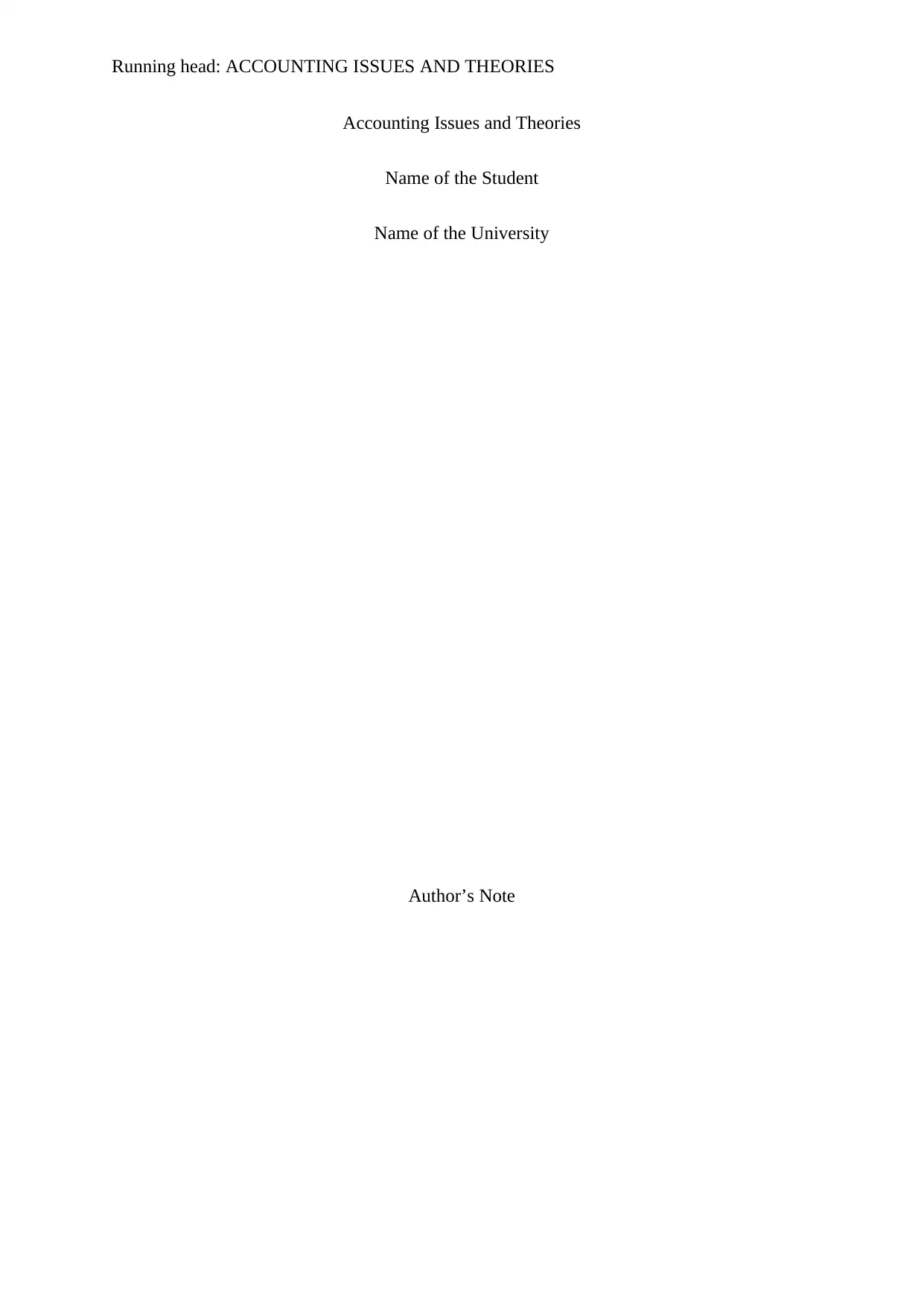
Running head: ACCOUNTING ISSUES AND THEORIES
Accounting Issues and Theories
Name of the Student
Name of the University
Author’s Note
Accounting Issues and Theories
Name of the Student
Name of the University
Author’s Note
Paraphrase This Document
Need a fresh take? Get an instant paraphrase of this document with our AI Paraphraser
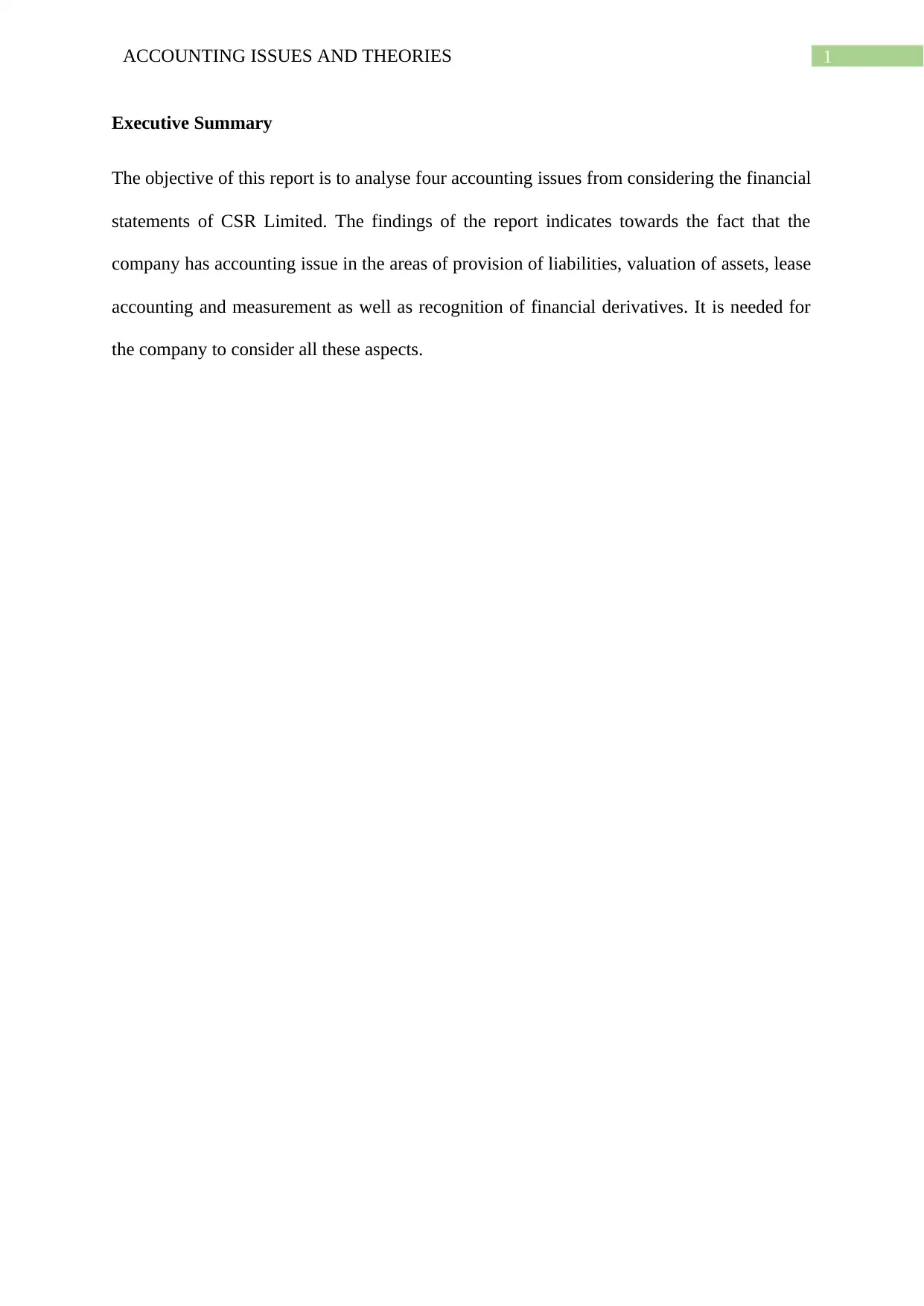
1ACCOUNTING ISSUES AND THEORIES
Executive Summary
The objective of this report is to analyse four accounting issues from considering the financial
statements of CSR Limited. The findings of the report indicates towards the fact that the
company has accounting issue in the areas of provision of liabilities, valuation of assets, lease
accounting and measurement as well as recognition of financial derivatives. It is needed for
the company to consider all these aspects.
Executive Summary
The objective of this report is to analyse four accounting issues from considering the financial
statements of CSR Limited. The findings of the report indicates towards the fact that the
company has accounting issue in the areas of provision of liabilities, valuation of assets, lease
accounting and measurement as well as recognition of financial derivatives. It is needed for
the company to consider all these aspects.
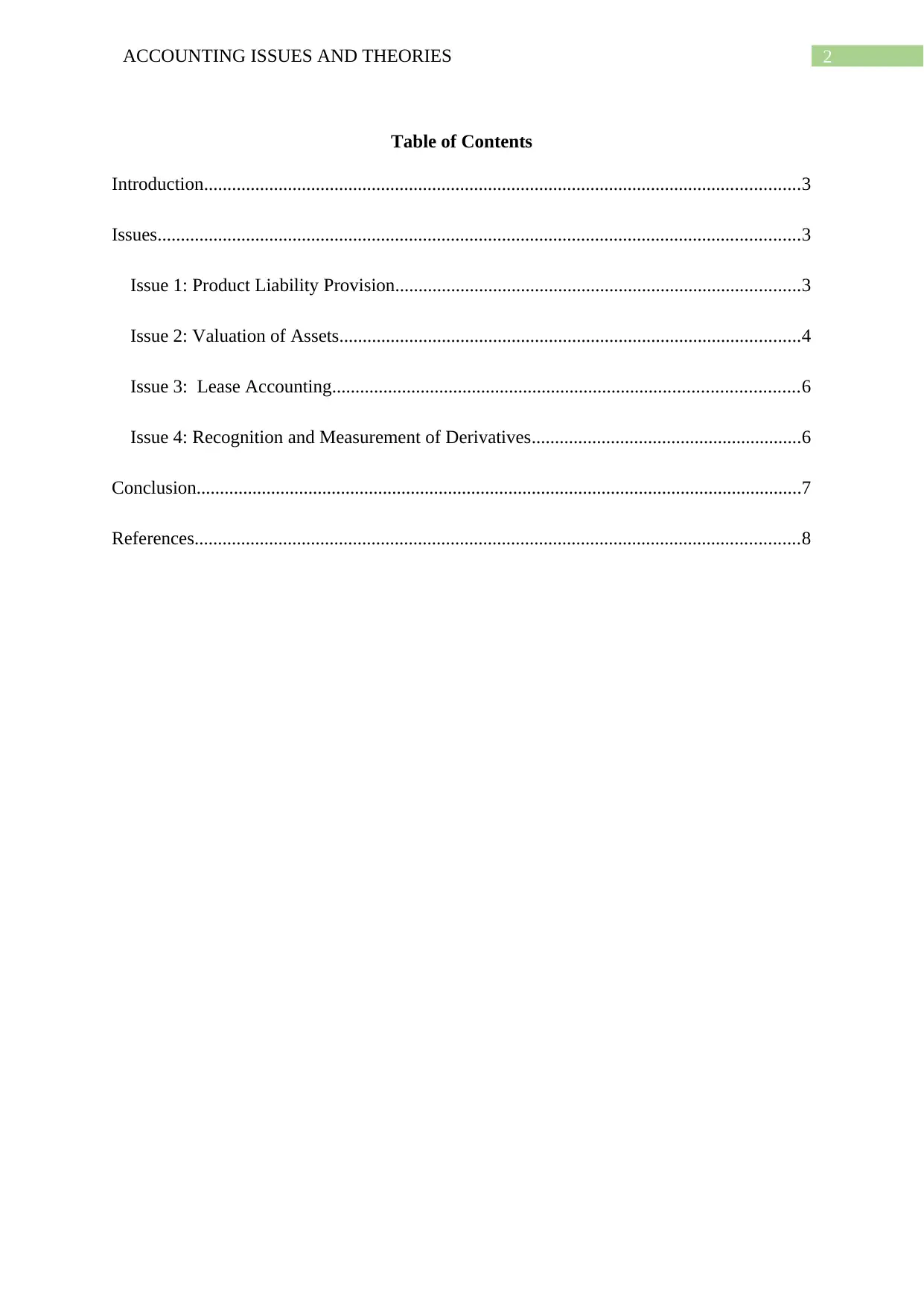
2ACCOUNTING ISSUES AND THEORIES
Table of Contents
Introduction................................................................................................................................3
Issues..........................................................................................................................................3
Issue 1: Product Liability Provision.......................................................................................3
Issue 2: Valuation of Assets...................................................................................................4
Issue 3: Lease Accounting....................................................................................................6
Issue 4: Recognition and Measurement of Derivatives..........................................................6
Conclusion..................................................................................................................................7
References..................................................................................................................................8
Table of Contents
Introduction................................................................................................................................3
Issues..........................................................................................................................................3
Issue 1: Product Liability Provision.......................................................................................3
Issue 2: Valuation of Assets...................................................................................................4
Issue 3: Lease Accounting....................................................................................................6
Issue 4: Recognition and Measurement of Derivatives..........................................................6
Conclusion..................................................................................................................................7
References..................................................................................................................................8
⊘ This is a preview!⊘
Do you want full access?
Subscribe today to unlock all pages.

Trusted by 1+ million students worldwide
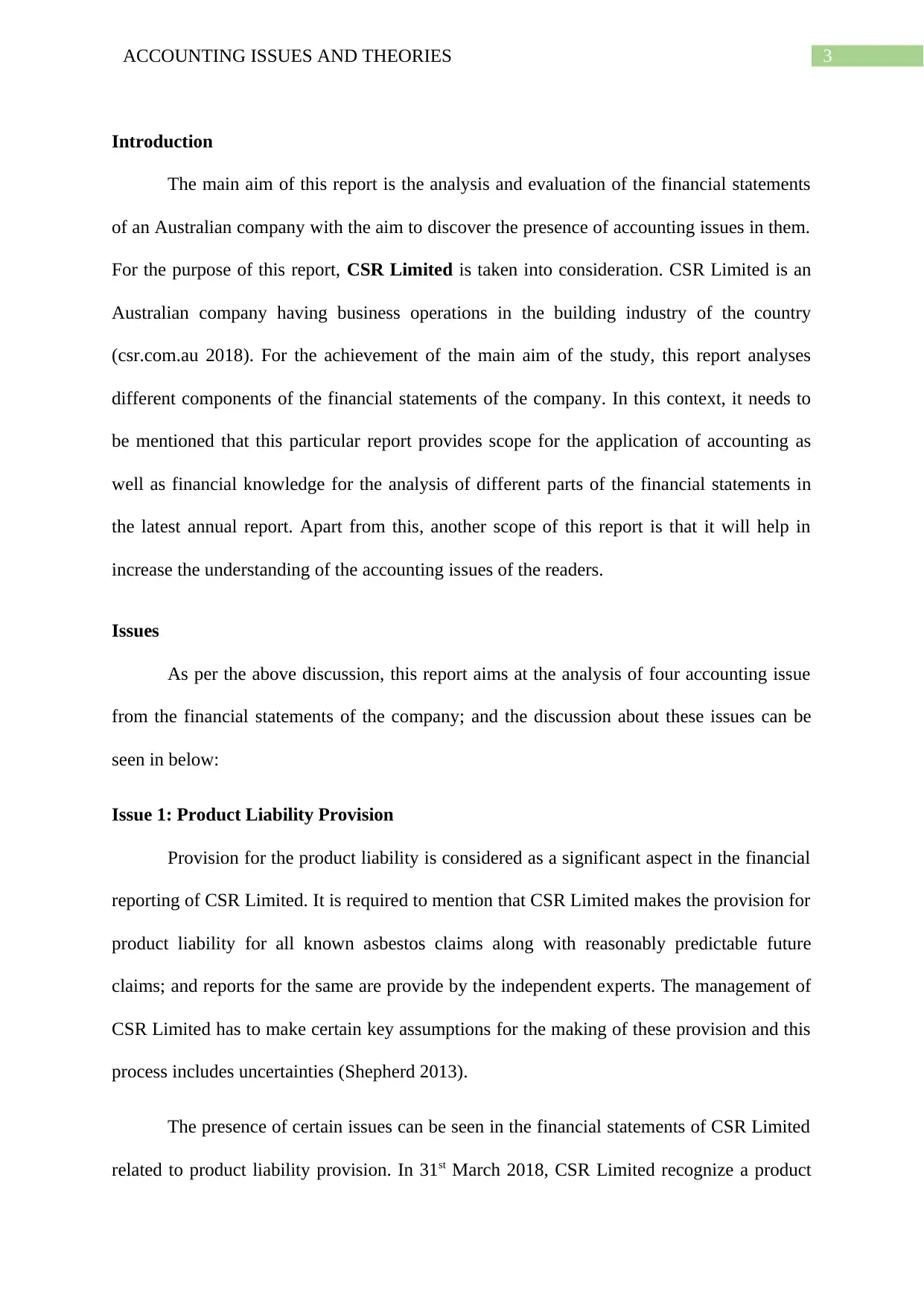
3ACCOUNTING ISSUES AND THEORIES
Introduction
The main aim of this report is the analysis and evaluation of the financial statements
of an Australian company with the aim to discover the presence of accounting issues in them.
For the purpose of this report, CSR Limited is taken into consideration. CSR Limited is an
Australian company having business operations in the building industry of the country
(csr.com.au 2018). For the achievement of the main aim of the study, this report analyses
different components of the financial statements of the company. In this context, it needs to
be mentioned that this particular report provides scope for the application of accounting as
well as financial knowledge for the analysis of different parts of the financial statements in
the latest annual report. Apart from this, another scope of this report is that it will help in
increase the understanding of the accounting issues of the readers.
Issues
As per the above discussion, this report aims at the analysis of four accounting issue
from the financial statements of the company; and the discussion about these issues can be
seen in below:
Issue 1: Product Liability Provision
Provision for the product liability is considered as a significant aspect in the financial
reporting of CSR Limited. It is required to mention that CSR Limited makes the provision for
product liability for all known asbestos claims along with reasonably predictable future
claims; and reports for the same are provide by the independent experts. The management of
CSR Limited has to make certain key assumptions for the making of these provision and this
process includes uncertainties (Shepherd 2013).
The presence of certain issues can be seen in the financial statements of CSR Limited
related to product liability provision. In 31st March 2018, CSR Limited recognize a product
Introduction
The main aim of this report is the analysis and evaluation of the financial statements
of an Australian company with the aim to discover the presence of accounting issues in them.
For the purpose of this report, CSR Limited is taken into consideration. CSR Limited is an
Australian company having business operations in the building industry of the country
(csr.com.au 2018). For the achievement of the main aim of the study, this report analyses
different components of the financial statements of the company. In this context, it needs to
be mentioned that this particular report provides scope for the application of accounting as
well as financial knowledge for the analysis of different parts of the financial statements in
the latest annual report. Apart from this, another scope of this report is that it will help in
increase the understanding of the accounting issues of the readers.
Issues
As per the above discussion, this report aims at the analysis of four accounting issue
from the financial statements of the company; and the discussion about these issues can be
seen in below:
Issue 1: Product Liability Provision
Provision for the product liability is considered as a significant aspect in the financial
reporting of CSR Limited. It is required to mention that CSR Limited makes the provision for
product liability for all known asbestos claims along with reasonably predictable future
claims; and reports for the same are provide by the independent experts. The management of
CSR Limited has to make certain key assumptions for the making of these provision and this
process includes uncertainties (Shepherd 2013).
The presence of certain issues can be seen in the financial statements of CSR Limited
related to product liability provision. In 31st March 2018, CSR Limited recognize a product
Paraphrase This Document
Need a fresh take? Get an instant paraphrase of this document with our AI Paraphraser
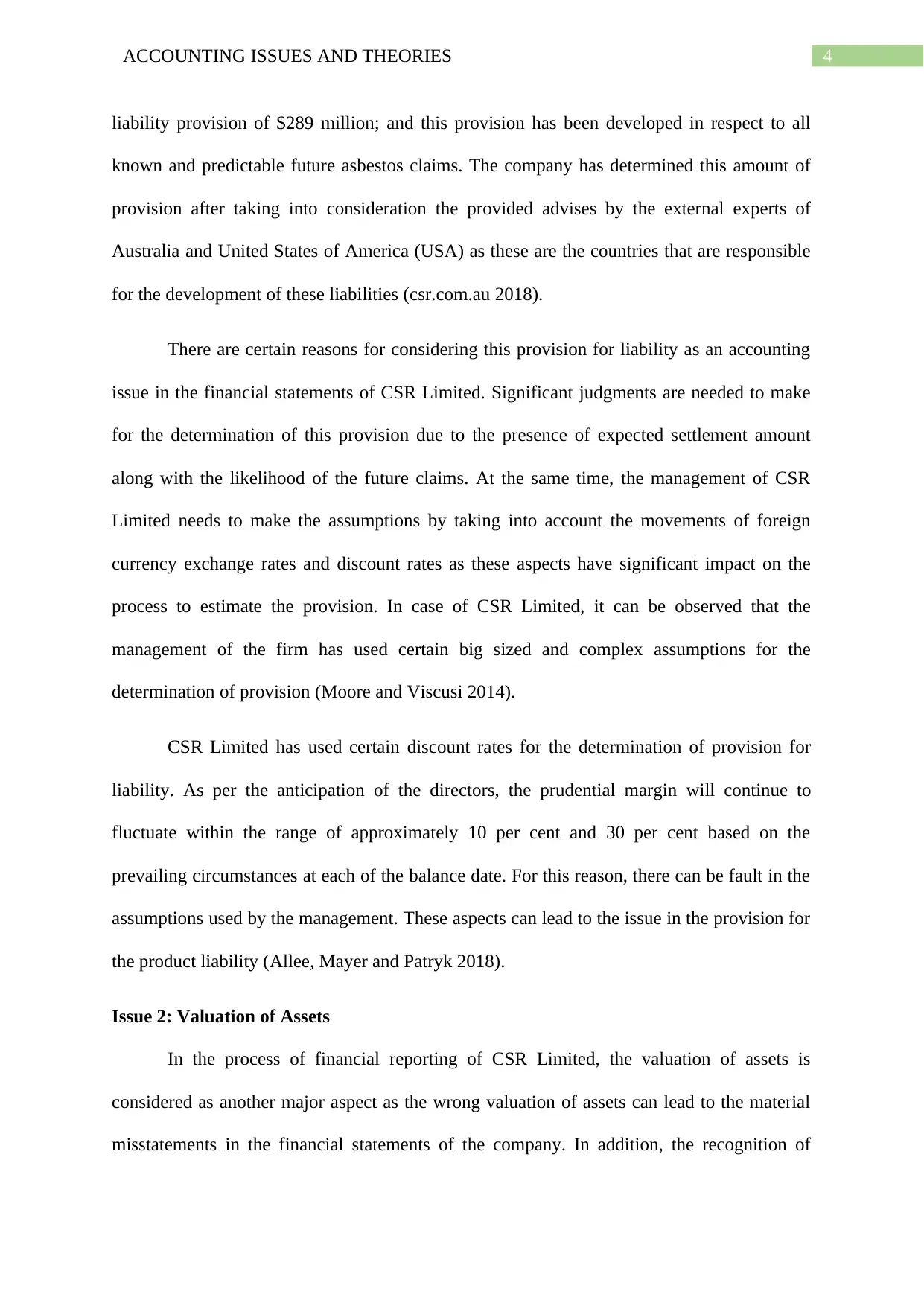
4ACCOUNTING ISSUES AND THEORIES
liability provision of $289 million; and this provision has been developed in respect to all
known and predictable future asbestos claims. The company has determined this amount of
provision after taking into consideration the provided advises by the external experts of
Australia and United States of America (USA) as these are the countries that are responsible
for the development of these liabilities (csr.com.au 2018).
There are certain reasons for considering this provision for liability as an accounting
issue in the financial statements of CSR Limited. Significant judgments are needed to make
for the determination of this provision due to the presence of expected settlement amount
along with the likelihood of the future claims. At the same time, the management of CSR
Limited needs to make the assumptions by taking into account the movements of foreign
currency exchange rates and discount rates as these aspects have significant impact on the
process to estimate the provision. In case of CSR Limited, it can be observed that the
management of the firm has used certain big sized and complex assumptions for the
determination of provision (Moore and Viscusi 2014).
CSR Limited has used certain discount rates for the determination of provision for
liability. As per the anticipation of the directors, the prudential margin will continue to
fluctuate within the range of approximately 10 per cent and 30 per cent based on the
prevailing circumstances at each of the balance date. For this reason, there can be fault in the
assumptions used by the management. These aspects can lead to the issue in the provision for
the product liability (Allee, Mayer and Patryk 2018).
Issue 2: Valuation of Assets
In the process of financial reporting of CSR Limited, the valuation of assets is
considered as another major aspect as the wrong valuation of assets can lead to the material
misstatements in the financial statements of the company. In addition, the recognition of
liability provision of $289 million; and this provision has been developed in respect to all
known and predictable future asbestos claims. The company has determined this amount of
provision after taking into consideration the provided advises by the external experts of
Australia and United States of America (USA) as these are the countries that are responsible
for the development of these liabilities (csr.com.au 2018).
There are certain reasons for considering this provision for liability as an accounting
issue in the financial statements of CSR Limited. Significant judgments are needed to make
for the determination of this provision due to the presence of expected settlement amount
along with the likelihood of the future claims. At the same time, the management of CSR
Limited needs to make the assumptions by taking into account the movements of foreign
currency exchange rates and discount rates as these aspects have significant impact on the
process to estimate the provision. In case of CSR Limited, it can be observed that the
management of the firm has used certain big sized and complex assumptions for the
determination of provision (Moore and Viscusi 2014).
CSR Limited has used certain discount rates for the determination of provision for
liability. As per the anticipation of the directors, the prudential margin will continue to
fluctuate within the range of approximately 10 per cent and 30 per cent based on the
prevailing circumstances at each of the balance date. For this reason, there can be fault in the
assumptions used by the management. These aspects can lead to the issue in the provision for
the product liability (Allee, Mayer and Patryk 2018).
Issue 2: Valuation of Assets
In the process of financial reporting of CSR Limited, the valuation of assets is
considered as another major aspect as the wrong valuation of assets can lead to the material
misstatements in the financial statements of the company. In addition, the recognition of
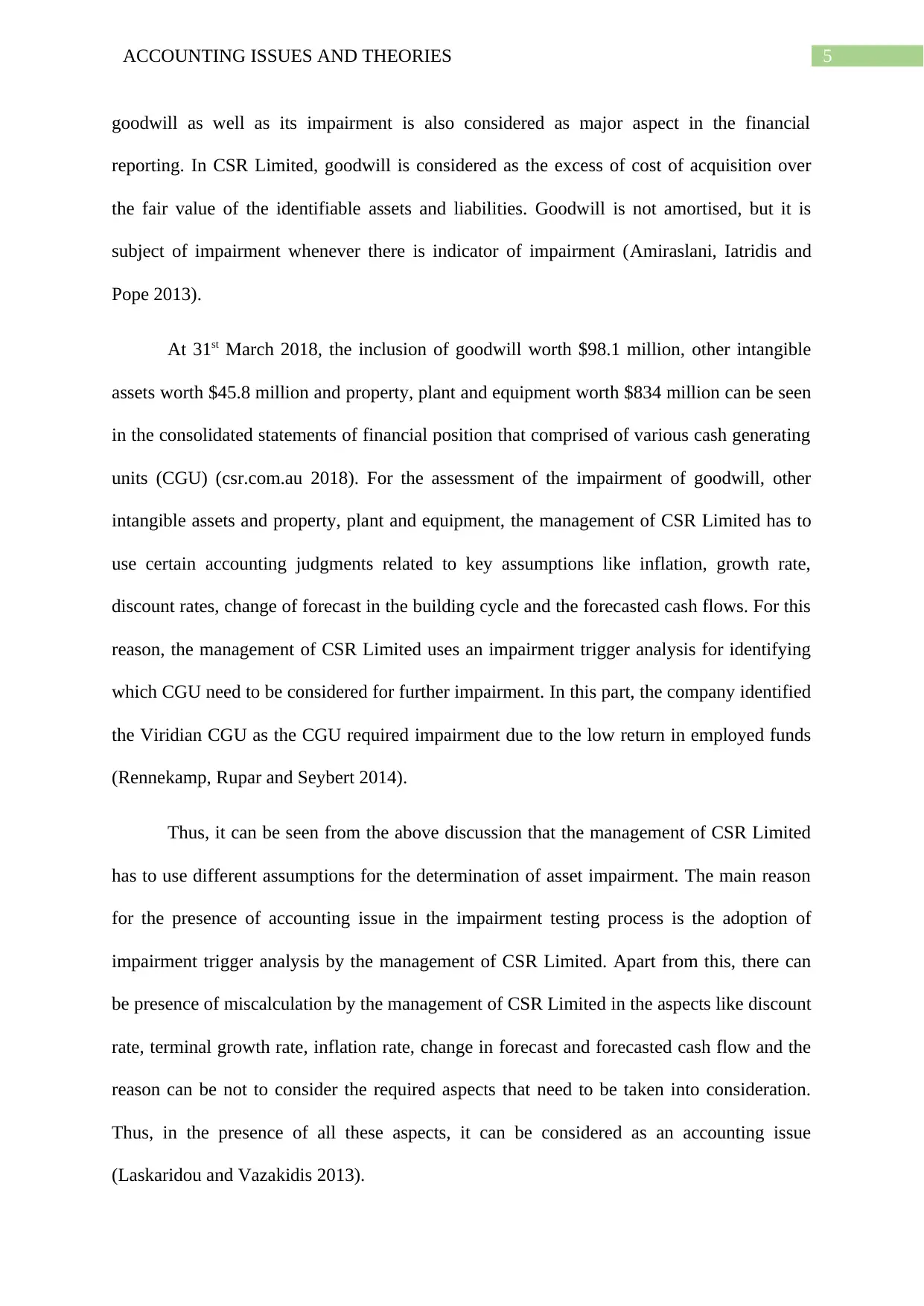
5ACCOUNTING ISSUES AND THEORIES
goodwill as well as its impairment is also considered as major aspect in the financial
reporting. In CSR Limited, goodwill is considered as the excess of cost of acquisition over
the fair value of the identifiable assets and liabilities. Goodwill is not amortised, but it is
subject of impairment whenever there is indicator of impairment (Amiraslani, Iatridis and
Pope 2013).
At 31st March 2018, the inclusion of goodwill worth $98.1 million, other intangible
assets worth $45.8 million and property, plant and equipment worth $834 million can be seen
in the consolidated statements of financial position that comprised of various cash generating
units (CGU) (csr.com.au 2018). For the assessment of the impairment of goodwill, other
intangible assets and property, plant and equipment, the management of CSR Limited has to
use certain accounting judgments related to key assumptions like inflation, growth rate,
discount rates, change of forecast in the building cycle and the forecasted cash flows. For this
reason, the management of CSR Limited uses an impairment trigger analysis for identifying
which CGU need to be considered for further impairment. In this part, the company identified
the Viridian CGU as the CGU required impairment due to the low return in employed funds
(Rennekamp, Rupar and Seybert 2014).
Thus, it can be seen from the above discussion that the management of CSR Limited
has to use different assumptions for the determination of asset impairment. The main reason
for the presence of accounting issue in the impairment testing process is the adoption of
impairment trigger analysis by the management of CSR Limited. Apart from this, there can
be presence of miscalculation by the management of CSR Limited in the aspects like discount
rate, terminal growth rate, inflation rate, change in forecast and forecasted cash flow and the
reason can be not to consider the required aspects that need to be taken into consideration.
Thus, in the presence of all these aspects, it can be considered as an accounting issue
(Laskaridou and Vazakidis 2013).
goodwill as well as its impairment is also considered as major aspect in the financial
reporting. In CSR Limited, goodwill is considered as the excess of cost of acquisition over
the fair value of the identifiable assets and liabilities. Goodwill is not amortised, but it is
subject of impairment whenever there is indicator of impairment (Amiraslani, Iatridis and
Pope 2013).
At 31st March 2018, the inclusion of goodwill worth $98.1 million, other intangible
assets worth $45.8 million and property, plant and equipment worth $834 million can be seen
in the consolidated statements of financial position that comprised of various cash generating
units (CGU) (csr.com.au 2018). For the assessment of the impairment of goodwill, other
intangible assets and property, plant and equipment, the management of CSR Limited has to
use certain accounting judgments related to key assumptions like inflation, growth rate,
discount rates, change of forecast in the building cycle and the forecasted cash flows. For this
reason, the management of CSR Limited uses an impairment trigger analysis for identifying
which CGU need to be considered for further impairment. In this part, the company identified
the Viridian CGU as the CGU required impairment due to the low return in employed funds
(Rennekamp, Rupar and Seybert 2014).
Thus, it can be seen from the above discussion that the management of CSR Limited
has to use different assumptions for the determination of asset impairment. The main reason
for the presence of accounting issue in the impairment testing process is the adoption of
impairment trigger analysis by the management of CSR Limited. Apart from this, there can
be presence of miscalculation by the management of CSR Limited in the aspects like discount
rate, terminal growth rate, inflation rate, change in forecast and forecasted cash flow and the
reason can be not to consider the required aspects that need to be taken into consideration.
Thus, in the presence of all these aspects, it can be considered as an accounting issue
(Laskaridou and Vazakidis 2013).
⊘ This is a preview!⊘
Do you want full access?
Subscribe today to unlock all pages.

Trusted by 1+ million students worldwide
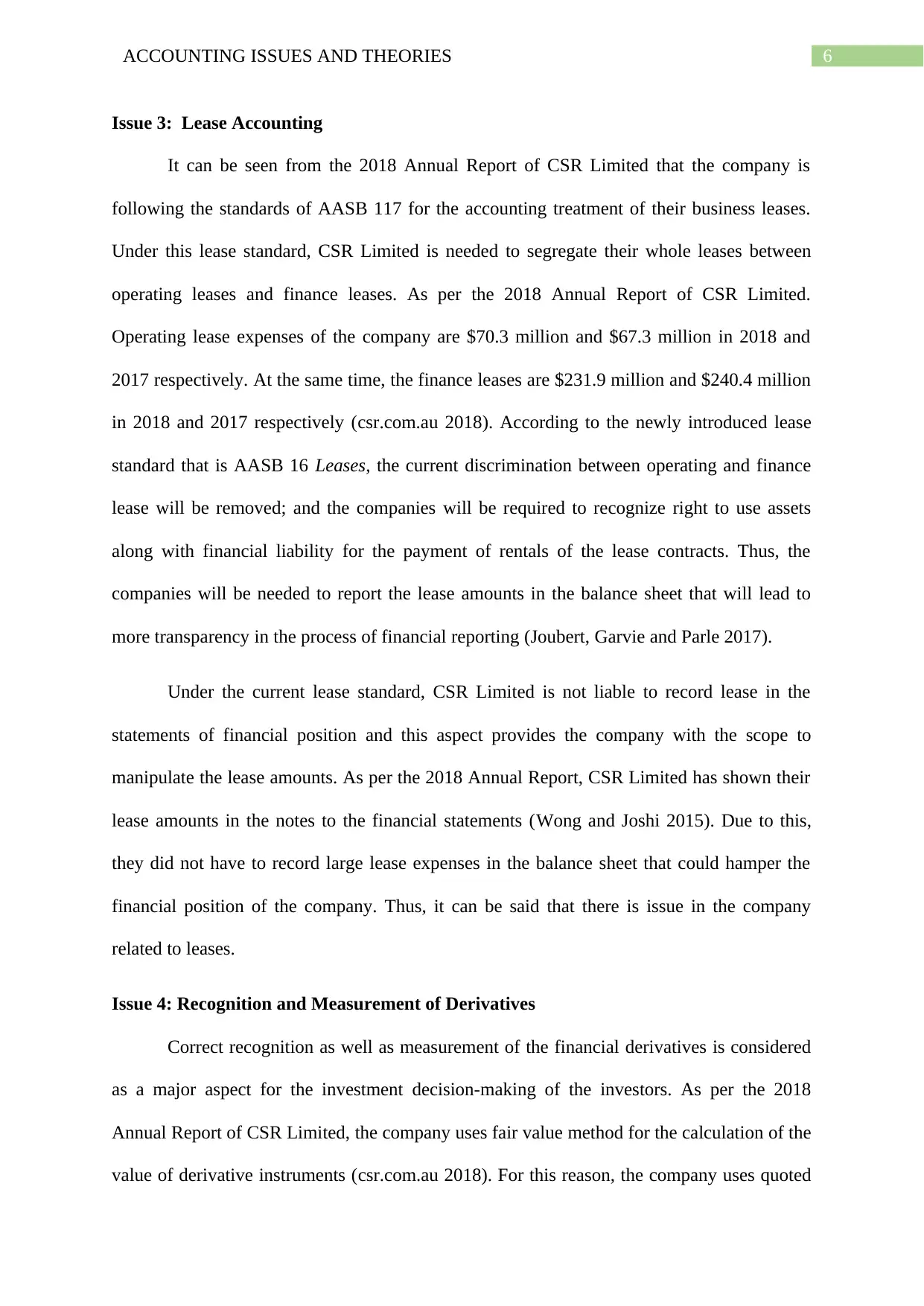
6ACCOUNTING ISSUES AND THEORIES
Issue 3: Lease Accounting
It can be seen from the 2018 Annual Report of CSR Limited that the company is
following the standards of AASB 117 for the accounting treatment of their business leases.
Under this lease standard, CSR Limited is needed to segregate their whole leases between
operating leases and finance leases. As per the 2018 Annual Report of CSR Limited.
Operating lease expenses of the company are $70.3 million and $67.3 million in 2018 and
2017 respectively. At the same time, the finance leases are $231.9 million and $240.4 million
in 2018 and 2017 respectively (csr.com.au 2018). According to the newly introduced lease
standard that is AASB 16 Leases, the current discrimination between operating and finance
lease will be removed; and the companies will be required to recognize right to use assets
along with financial liability for the payment of rentals of the lease contracts. Thus, the
companies will be needed to report the lease amounts in the balance sheet that will lead to
more transparency in the process of financial reporting (Joubert, Garvie and Parle 2017).
Under the current lease standard, CSR Limited is not liable to record lease in the
statements of financial position and this aspect provides the company with the scope to
manipulate the lease amounts. As per the 2018 Annual Report, CSR Limited has shown their
lease amounts in the notes to the financial statements (Wong and Joshi 2015). Due to this,
they did not have to record large lease expenses in the balance sheet that could hamper the
financial position of the company. Thus, it can be said that there is issue in the company
related to leases.
Issue 4: Recognition and Measurement of Derivatives
Correct recognition as well as measurement of the financial derivatives is considered
as a major aspect for the investment decision-making of the investors. As per the 2018
Annual Report of CSR Limited, the company uses fair value method for the calculation of the
value of derivative instruments (csr.com.au 2018). For this reason, the company uses quoted
Issue 3: Lease Accounting
It can be seen from the 2018 Annual Report of CSR Limited that the company is
following the standards of AASB 117 for the accounting treatment of their business leases.
Under this lease standard, CSR Limited is needed to segregate their whole leases between
operating leases and finance leases. As per the 2018 Annual Report of CSR Limited.
Operating lease expenses of the company are $70.3 million and $67.3 million in 2018 and
2017 respectively. At the same time, the finance leases are $231.9 million and $240.4 million
in 2018 and 2017 respectively (csr.com.au 2018). According to the newly introduced lease
standard that is AASB 16 Leases, the current discrimination between operating and finance
lease will be removed; and the companies will be required to recognize right to use assets
along with financial liability for the payment of rentals of the lease contracts. Thus, the
companies will be needed to report the lease amounts in the balance sheet that will lead to
more transparency in the process of financial reporting (Joubert, Garvie and Parle 2017).
Under the current lease standard, CSR Limited is not liable to record lease in the
statements of financial position and this aspect provides the company with the scope to
manipulate the lease amounts. As per the 2018 Annual Report, CSR Limited has shown their
lease amounts in the notes to the financial statements (Wong and Joshi 2015). Due to this,
they did not have to record large lease expenses in the balance sheet that could hamper the
financial position of the company. Thus, it can be said that there is issue in the company
related to leases.
Issue 4: Recognition and Measurement of Derivatives
Correct recognition as well as measurement of the financial derivatives is considered
as a major aspect for the investment decision-making of the investors. As per the 2018
Annual Report of CSR Limited, the company uses fair value method for the calculation of the
value of derivative instruments (csr.com.au 2018). For this reason, the company uses quoted
Paraphrase This Document
Need a fresh take? Get an instant paraphrase of this document with our AI Paraphraser

7ACCOUNTING ISSUES AND THEORIES
market price for the derivative valuation; and they use discounted cash flow analysis in case
market prices are not available. At the same time, they are also measured with the use of
quoted exchange rates and yield curves derived from quoted rate of interest (Bingham and
Kiesel 2013). Thus, it can be seen that the company has to consider many aspects with the
aim to ascertain the approximate carrying value of the financial derivate. Hence, in the
absence of exact value of the financial derivatives, the shareholders of CSR Limited can face
major difficulties in the process to make effective investment decisions (Hammoudeh and
McAleer 2013). For this reason, it can be considered as issue in the financial statements of
CSR Limited.
Conclusion
It can be seen from the above discussion that CSR Limited has certain accounting
issues in their business. As per the first issue, uncertain assumptions in the aspects like
inflation rate, discount rate and others has led to the improper calculation of the provision of
liability worth $289 million in 2018. The second issue can be seen in the impairment testing
of goodwill, other intangible assets and property, plant and equipment in the presence of
major uncertainties in the assumptions used by the company. As per the third issue, there is a
scope of manipulation in the lease amounts of CSR Limited due to the adherence to the
standard of AASB 117 Leases. As per the last issue, the company is facing uncertainty in the
exact valuation of financial derivatives that can lead to accounting issue.
market price for the derivative valuation; and they use discounted cash flow analysis in case
market prices are not available. At the same time, they are also measured with the use of
quoted exchange rates and yield curves derived from quoted rate of interest (Bingham and
Kiesel 2013). Thus, it can be seen that the company has to consider many aspects with the
aim to ascertain the approximate carrying value of the financial derivate. Hence, in the
absence of exact value of the financial derivatives, the shareholders of CSR Limited can face
major difficulties in the process to make effective investment decisions (Hammoudeh and
McAleer 2013). For this reason, it can be considered as issue in the financial statements of
CSR Limited.
Conclusion
It can be seen from the above discussion that CSR Limited has certain accounting
issues in their business. As per the first issue, uncertain assumptions in the aspects like
inflation rate, discount rate and others has led to the improper calculation of the provision of
liability worth $289 million in 2018. The second issue can be seen in the impairment testing
of goodwill, other intangible assets and property, plant and equipment in the presence of
major uncertainties in the assumptions used by the company. As per the third issue, there is a
scope of manipulation in the lease amounts of CSR Limited due to the adherence to the
standard of AASB 117 Leases. As per the last issue, the company is facing uncertainty in the
exact valuation of financial derivatives that can lead to accounting issue.
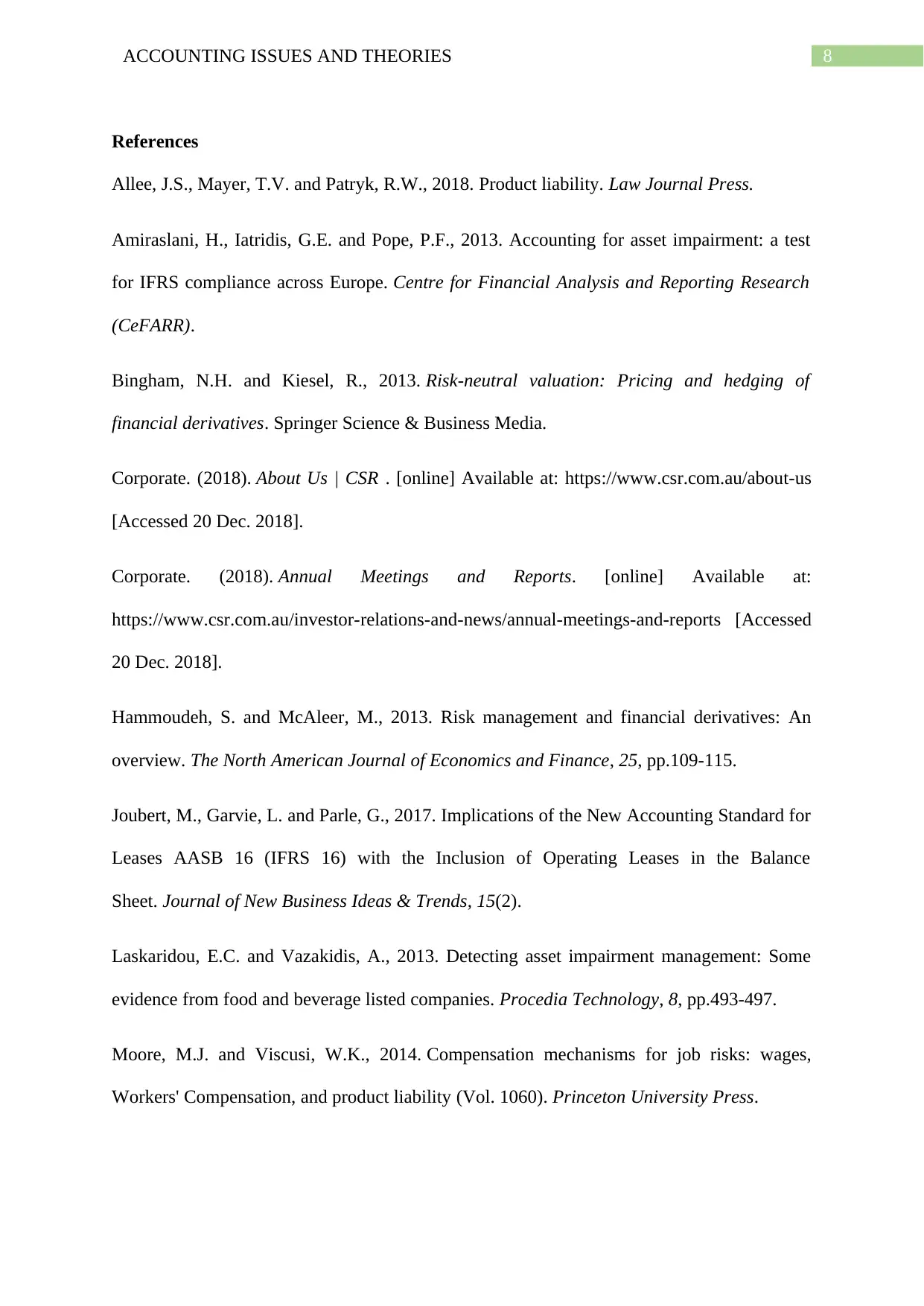
8ACCOUNTING ISSUES AND THEORIES
References
Allee, J.S., Mayer, T.V. and Patryk, R.W., 2018. Product liability. Law Journal Press.
Amiraslani, H., Iatridis, G.E. and Pope, P.F., 2013. Accounting for asset impairment: a test
for IFRS compliance across Europe. Centre for Financial Analysis and Reporting Research
(CeFARR).
Bingham, N.H. and Kiesel, R., 2013. Risk-neutral valuation: Pricing and hedging of
financial derivatives. Springer Science & Business Media.
Corporate. (2018). About Us | CSR . [online] Available at: https://www.csr.com.au/about-us
[Accessed 20 Dec. 2018].
Corporate. (2018). Annual Meetings and Reports. [online] Available at:
https://www.csr.com.au/investor-relations-and-news/annual-meetings-and-reports [Accessed
20 Dec. 2018].
Hammoudeh, S. and McAleer, M., 2013. Risk management and financial derivatives: An
overview. The North American Journal of Economics and Finance, 25, pp.109-115.
Joubert, M., Garvie, L. and Parle, G., 2017. Implications of the New Accounting Standard for
Leases AASB 16 (IFRS 16) with the Inclusion of Operating Leases in the Balance
Sheet. Journal of New Business Ideas & Trends, 15(2).
Laskaridou, E.C. and Vazakidis, A., 2013. Detecting asset impairment management: Some
evidence from food and beverage listed companies. Procedia Technology, 8, pp.493-497.
Moore, M.J. and Viscusi, W.K., 2014. Compensation mechanisms for job risks: wages,
Workers' Compensation, and product liability (Vol. 1060). Princeton University Press.
References
Allee, J.S., Mayer, T.V. and Patryk, R.W., 2018. Product liability. Law Journal Press.
Amiraslani, H., Iatridis, G.E. and Pope, P.F., 2013. Accounting for asset impairment: a test
for IFRS compliance across Europe. Centre for Financial Analysis and Reporting Research
(CeFARR).
Bingham, N.H. and Kiesel, R., 2013. Risk-neutral valuation: Pricing and hedging of
financial derivatives. Springer Science & Business Media.
Corporate. (2018). About Us | CSR . [online] Available at: https://www.csr.com.au/about-us
[Accessed 20 Dec. 2018].
Corporate. (2018). Annual Meetings and Reports. [online] Available at:
https://www.csr.com.au/investor-relations-and-news/annual-meetings-and-reports [Accessed
20 Dec. 2018].
Hammoudeh, S. and McAleer, M., 2013. Risk management and financial derivatives: An
overview. The North American Journal of Economics and Finance, 25, pp.109-115.
Joubert, M., Garvie, L. and Parle, G., 2017. Implications of the New Accounting Standard for
Leases AASB 16 (IFRS 16) with the Inclusion of Operating Leases in the Balance
Sheet. Journal of New Business Ideas & Trends, 15(2).
Laskaridou, E.C. and Vazakidis, A., 2013. Detecting asset impairment management: Some
evidence from food and beverage listed companies. Procedia Technology, 8, pp.493-497.
Moore, M.J. and Viscusi, W.K., 2014. Compensation mechanisms for job risks: wages,
Workers' Compensation, and product liability (Vol. 1060). Princeton University Press.
⊘ This is a preview!⊘
Do you want full access?
Subscribe today to unlock all pages.

Trusted by 1+ million students worldwide
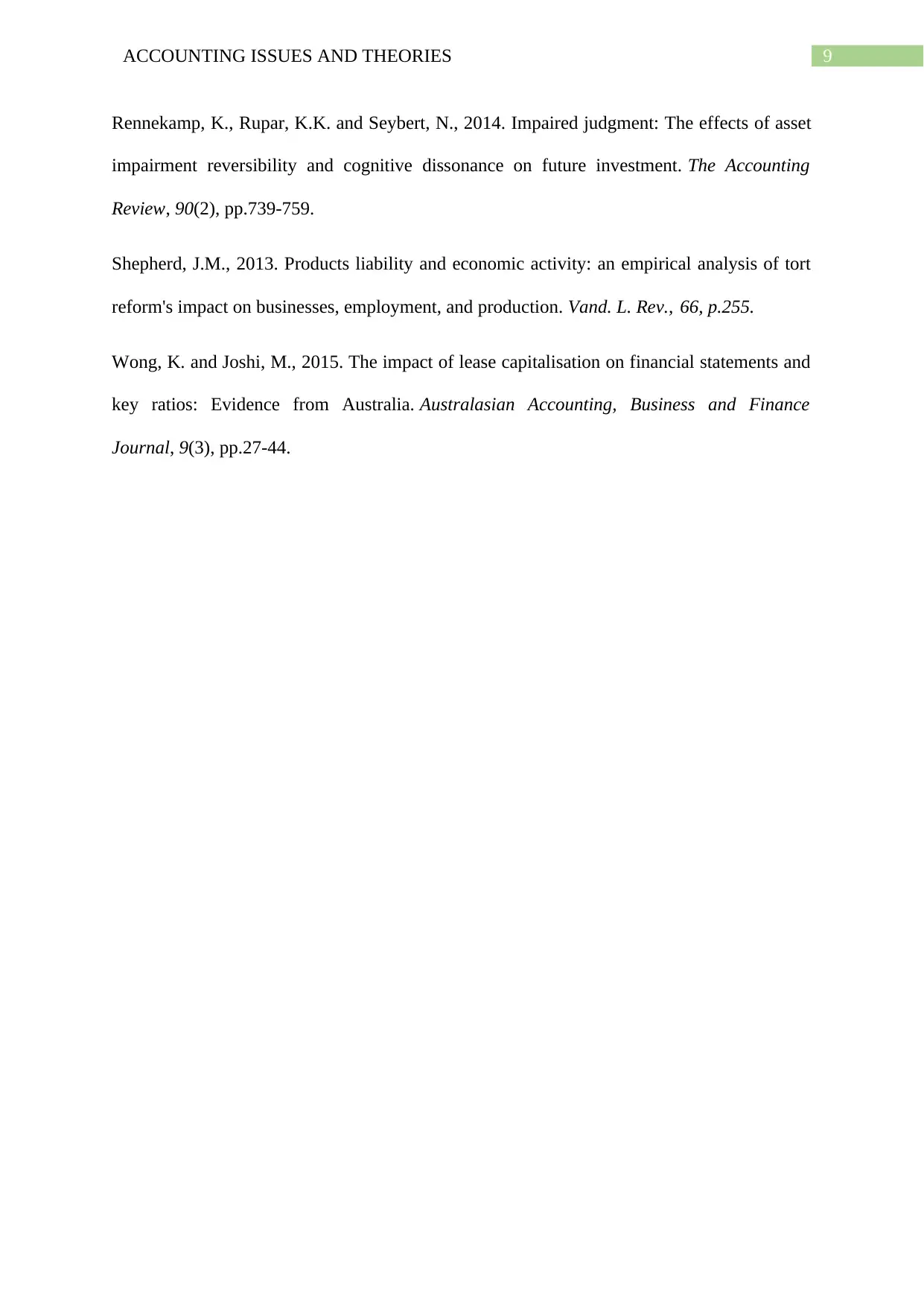
9ACCOUNTING ISSUES AND THEORIES
Rennekamp, K., Rupar, K.K. and Seybert, N., 2014. Impaired judgment: The effects of asset
impairment reversibility and cognitive dissonance on future investment. The Accounting
Review, 90(2), pp.739-759.
Shepherd, J.M., 2013. Products liability and economic activity: an empirical analysis of tort
reform's impact on businesses, employment, and production. Vand. L. Rev., 66, p.255.
Wong, K. and Joshi, M., 2015. The impact of lease capitalisation on financial statements and
key ratios: Evidence from Australia. Australasian Accounting, Business and Finance
Journal, 9(3), pp.27-44.
Rennekamp, K., Rupar, K.K. and Seybert, N., 2014. Impaired judgment: The effects of asset
impairment reversibility and cognitive dissonance on future investment. The Accounting
Review, 90(2), pp.739-759.
Shepherd, J.M., 2013. Products liability and economic activity: an empirical analysis of tort
reform's impact on businesses, employment, and production. Vand. L. Rev., 66, p.255.
Wong, K. and Joshi, M., 2015. The impact of lease capitalisation on financial statements and
key ratios: Evidence from Australia. Australasian Accounting, Business and Finance
Journal, 9(3), pp.27-44.
1 out of 10
Related Documents
Your All-in-One AI-Powered Toolkit for Academic Success.
+13062052269
info@desklib.com
Available 24*7 on WhatsApp / Email
![[object Object]](/_next/static/media/star-bottom.7253800d.svg)
Unlock your academic potential
Copyright © 2020–2025 A2Z Services. All Rights Reserved. Developed and managed by ZUCOL.




